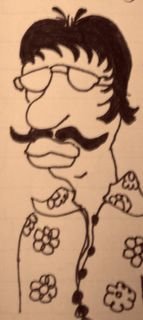Have you ever seen those old black and white photos that have been touched up with paint? With the color filled in by an artist, the images becomes a strange and beautiful blur of reality. When I worked at Walgreen's as a photo tech, I had people come in with black and white film and say "I want this developed with a little bit of color." It was nearly impossible to explain to these people how what they were asking was, physically impossible. What does all that have to do with AGAINST THE DAY? Well as I read the novel, that's what I see in my head--that's how this works is being processed by my brain, it's black and white photo with the color hand painted in.
Set in the just prior to World War I (Francis Ferdinand-the Archduke whose infamous assassination triggered Europe's powder keg-has already made a cameo) AGAINST THE DAY exists in the twilight of the Victorian Age. The modern world is looming (as is war). The novel opens with the aeronautic club, The Chums of Chance, flying their gondola to the Chicago World's Fair. They get there and are hired by a local detective agency to help provide security for the event (their eyes from above provide an excellent vantage point for spotting those dastardly trade Union-terrorists).
I've heard that this novel has a crap load of characters, so I'm keeping a score sheet. Thus far (the first 69 pages) there are about 35 characters. Granted, not all of these are very important to the storyline...which is...???? Pynchon is great at swinging in and out of the main story. A new character will appear, he gives the reader a little back story...pretty soon you're wrapped up in this complex (and bizarre) off shoot. So far, they've all been very entertaining, so much so that by the time you realize "Hey, this has nothing to do with what is going on" you're back BAM! smack into the main story. This makes for some challenging reading (you have to keep track of who is who but also what happened to who (and when)). Many of the characters have a lot of overlap (a random photographer they Chums meet turns out to be a friend of their inventor benefactor Professor Vanderjuice).
Another thing that Pynchon is doing (that I like and think is funny) is refer to previous "books" detailing the Chums previous adventures. For example, when discussing Miles Blundell's fascination with the ukulele Pynchon writes "Since their Hawaiian escapades a few years previous (The Chums of Chance and the Curse of the Great Kahuna), Miles had become an enthusiastic ukulelist..." This kind of thing amuses me (because no where else does the narrative pretend to be a book, only when referring to other, imaginary adventure books, does the narrative voice let on that you're reading a novel).
Pynchon also writes a lot of science, or more often pseudo-science. I recently finished a section about (what appears for now to be) a minor character's interest in the famous Michelson-Morley experiment (where they proved that aether doesn't exist). Basically, in the 19th century it was thought that light (like water and sound) must travel through some type of medium...but because light can travel through a vacuum (space) it was thought that even a vacuum must contain a medium for light (the invisible, weightless, substance less aether). Michelson and Morley proved that aether didn't exist (don't ask me how, but they did). Now, how do I know all of this? Because I had to get up off my ass and do some research online. Pynchon discusses aether and the Michelson-Morley experiment in terms of "Hey, you know those crazy guys in Cleveland doing that experiment?" and "What about that aether, huh? Crazy stuff..." you either know this shit or you don't (you won't for the most part) and Pynchon rarely throws you a bone (or a life preserver). It's sink or swim baby.
So basically, if this book is so much work, why bother? I can't explain it...but here goes: for one thing, the book is very entertaining. Robots, talking/reading dogs, air ships, adventure, Telsa, conspiracies...all the good stuff is mixed together like cookie batter. It's tasty. Pynchon doesn't write down to you, he expects you to do a little outside reading, but it pays off because now I know about aether and the pseudo-science surrounding it at the turn of the century. I know that two guys in Ohio, Michelson and Morley proved it was bunk. Yay for learning! Also, the human aspect is there. Pynchon has two characters, that despite the mere 60+ pages have my emotional interest. One character, Lew Basnight, has done something terrible...but he can't remember what it was. Everyone else in Chicago (it seems) can remember but refuses to tell him. His wife leaves him, refusing to tell him "because to repeat it would mean I'd have to relive it." Now Basnight is trying to atone for a sin he can't remember committing (think about the religious implications there, folks). Much like the Chums of Chance, the reader feels like he/she is on a journey. But instead of being a passive observer, the reader is brought into the novel's world through careful reading and a little reseach.
Many books claim to be epic, but few actually are. Inside the pages of AGAINST THE DAY is an entire living, breathing world--populated by countless people and ideas. I can't wait to see what the next 1,000 pages have in store.
Thursday, March 22, 2007
Subscribe to:
Post Comments (Atom)






No comments:
Post a Comment